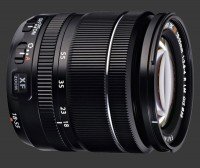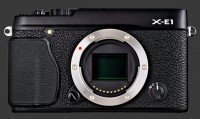Fujifilm X-E1 Review
Fujifilm X-E1 Performance - How well does it take pictures?
Performance starts with image quality, which is the criteria used as the foundation of our digital camera ratings. Ergonomic issues may get in the way, but in the end, image quality counts the most. For an ILC, image quality greatly depends on the lens used. While color, noise, exposure and dynamic-range are properties of a camera, distortion, vignetting and chromatic aberrations are properties of the lens. Sharpness and contrast depend on the weakest link. That is, a camera cannot capture more details than a lens lets through. Conversely, it is quite possible for a lens to transmit more details than a sensor can capture.
Image Noise & Details
The Fuji X-E1 produces images of exceptional quality, exceeding the quality of the almost all cropped-sensor DSLR throughout its range of ISO sensitivities, making it even comparable to some full-frame models. Image noise is inexistent all the way to ISO 1600 and becomes barely detectable at ISO 3200. ISO 6400 is almost the same and only at ISO 12800 do some details get affected by noise. Still, mid-size prints are possible at such high sensitivity and even at ISO 25600, which is visibly noisy.
While we know the unique X-Trans sensor delivers in terms of sharpness from the X-Pro1 review, output was not so sharp with the X-E1 since the only lens available for testing was the Fuji zoom. Even so, fine-details get resolved by that lens, albeit with lower local contrast.
Sharpness is controllable in 5 levels. Things start from a very soft to over-sharp, so each step is quite coarse. The default level leaves a little softness but the one above unfortunately adds sharpening artifacts. It is probably better to add sharpening later when preparing an image according to the intended output medium. Image noise reduction works well with the new color-filter-array and maintains image sharpness. There are 5 levels of noise reduction and they extremely close in output quality.

Color & White Balance
Color accuracy of the X-E1 is very good. Hues realistic with different Film Simulation mode mostly affecting saturation. The standard Provia film exaggerates saturation which can be improved by setting Color to -1. Alternately, using Pro Negative Standard film simulation provides a similar rendition of color.
Automatic White-Balance is quite dependable under typical conditions. It handles both natural and artificial lighting surprisingly well, only leave the occasional yellow cast for incandescent and magenta for fluorescent. The twisted issue though is that AWB is often previewed incorrectly, tricking the user into incorrectly changing settings. The Custom White-Balance option is there for difficult situations and is perfectly accurate.
Exposure
Multi-Segment metering produces results of average brightness, very reliably and consistently. It often ignores small highlights which may cause overexposure sometimes. Usually less than one stop EC is required for a better and more conservative exposure. Average and Spot metering work exactly as intended.
Dynamic-Range of the X-E1 is relatively good. This can be increased to 200% starting at ISO 400 and to 400% starting at ISO 800 all the way to 6400. This camera handles high-contrast scenes even better than most other mirrorless cameras but not as well as top-of-the-line DSLRs.

Auto Focus
Autofocus has been visibly improved from the X-Pro1, yet it remains a weak point of the X-E1. Both speed and sensitivity of the autofocus system are better than before.
The Fuji X-E1 employs a Contrast-Detection AF system which is on the slow side by current standards. In good light, it is able to lock focus in less than ½s which is sufficient for stationary object but it wont catch something moving at a reasonable pace. In moderate light, such as typical household lighting, autofocus often takes long, sometimes exceeding 1s.
Continuous AF (AF-C) is not very useful either since it spends a considerable amount of time catching up. It takes roughly 1s for it to refocus in typical indoor lighting, so it struggles with everything that moves. The AF system gives up quicker than usual too, both in AF-S and AF-C mode.
Spot-Focus, sometimes called AF-On by other brands, lets the X-E1 autofocus on-demand while in MF mode. Simply press the AE-L / AF-L button and, ½s to 1s later, focus will usually lock. Manual Focusing is done via a fly-by-wire ring at the front of current XF-mount lenses.

Speed
Except for its sluggish autofocus system, the Fuji X-E1 is quick and responsive. Nearly all actions occur without delay. It can shoot continuous at 6 FPS which is comparable to high-end DSLRs but notably slower than many of the latest mirrorless models from Olympus and Sony. The buffer is capable of absorbing 20 JPEG images or 12 RAW in one burst while using a fast memory card.
The following measurements characterize the performance of the Fuji X-E1:
- Power-On: Less than 1 seconds. Quite good.
- Power-On to First-Shot: 1½ seconds. Average.
- Autofocus: ½ in good light, 1s or more in low light. Below average.
- Shutter-lag: Immediate with under ½s blackout. Very good.
- Shot-to-shot: Just under 2s with AF, 1¼ in MF. On the slow side.
- Playback: About 3/4s to enter or exist. On the slow side.
- Power-Off: 1 second, includes sensor cleaning. Good.
- Video: Nearly instant starting and stopping. Better than most.
The performance of the X-E1 shows some strengths and limitations. This camera is read to shoot quickly and remains quite responsive. The improved but still slow autofocus performance makes it not suitable for action, candids and journalism. More stationary subjects are not a problem though.
Having a true video mode makes the camera ready to start recording immediately and preview framing correctly. This is not so common among modern digital cameras, so despite Fuji not having emphasized video in the X-E1, it works perfectly. Focus in video can either by continuous or manual. As always, MF is highly recommended for video, even more so because of the back and forth movement required by Contrast-Detect AF.
The Fuji X-E1 is powered by a small proprietary Lithium-Ion battery which provides 350 shots-per-charge. This is about average and goes down quickly while reviewing images. Another battery is highly recommended not to run out unexpectedly. The small size of the battery makes it quite sensitive to cold and hardly be able to shoot even half its quoted maximum as temperatures approach freezing.
Fujifilm X-E1 Conclusion

The Fuji X-E1 is a great successor to the X-Pro1. It keeps the highly tactile interface and unique 16 megapixels X-Trans CMOS sensor while improving in key areas. The more compact design is critical to success among a growing number of mirrorless cameras, plus the new ultra-high-resolution 2.4 megapixels EVF makes for an exceptional usability at eye-level.
Image quality of the Fuji X-E1 is top-notch and exceeds all non-Fuji mirrorless cameras. Image noise is virtually inexistent until ISO 3200 and only slowly progresses without the usual added softness of noise-reduction. The output of this camera is completely usable for mid-size prints until ISO 25600. Sharpness is reasonably good with the Fujifilm Fujinon XF18-55mm F/2.8-4R LM OIS
Fujifilm Fujinon XF18-55mm F/2.8-4R LM OIS but can be excellent with a prime lens. Metering, color and white-balance are all very good too.
While the X-E1 shows some good performance numbers and is a generally speedy camera, it falters when it comes to focusing. Autofocus speed is sluggish, particularly in low-light. Whereas the X-Pro1 struggled even in moderate indoor lighting, the Fuji X-E1 clearly does better, yet remains behind the fastest mirrorless cameras.
As an early XF-Mount camera, the X-E1 presents a difficult choice. The amazing image quality is very attractive but having a choice of only a few lenses limits photographic potential. However, the Fuji X-E1 is competitively priced according to image quality, given how well it compares with much more expensive DSLRs.
 |
Please Support Neocamera
All information on Neocamera is provided free of charge yet running this website is a huge endeavor. Purchases made via affiliate links found throughout the site help keep it running and up-to-date. There is no additional cost to you, so please consider buying via these links to our affilates:
If you found any information on this site valuable and did not purchase via our affiliate links, please considering donating via PayPal:
Any amount will be greatly appreaciated. Thank you for your support!
Fujifilm X-E1 Highlights

Sensor-Size: 24 x 16mm

Actual size when viewed at 100 DPI
| 16 Megapixels Mirrorless | ISO 100-25600 |
| Fujifilm X Mount 1.5X FLM | Shutter 1/4000-30s |
| 0.50" Built-in EVF 2.4 Megapixels (0.62X) | Full manual controls, including Manual Focus |
| Automatic Eye-Start sensor | Custom white-balance with 2 axis fine-tuning |
| 1 Axis Digital Level | Spot-Metering |
| Built-in Dust Reduction | Hot-Shoe |
| 6 FPS Drive, 20 Images | Stereo audio input |
| 1920x1080 @ 24 FPS Video Recording | Lithium-Ion Battery |
| 2.8" LCD 460K Pixels | Secure Digital Extended Capacity |
Updates
2025.01.18

Fujifilm GFX 2025 Lens Roundup
Lens Review roundup of Fujifilm GFX Medium-Format lenses. Quality, performance and handling of the GF20-35mm F/4R WR, GF30mm F/3.5 Tilt-Shift and the GF55mm F/1.7.
2024.11.18

Best 2024 Photography Gifts for Every Budget
Great gifts for photographers and photo enthusiasts selected for every budget among the best products of 2024.
2024.08.07

Eye Protection Tips for Professional Photographers
The four main considerations for professional photographers regarding eyewear.
2024.07.14

Fujifilm X100VI Review
Flagship fixed-lens compact digital camera with a 40 MP sensor and Image-Stabilization, a first for the series. Retro design featuring dual control-dials, plus direct ISO, Shutter-Speed and EC dials. Its hybrid viewfinder can switch between EVF and OVF mode.
2024.05.09

Fujifilm GFX100 II Review
Flagship 102 Megapixels Medium-Format Mirrorless Digital Camera with 8-Stop 5-Axis IBIS, 8 FPS Drive, 8K Video and 400 MP Super-Resolution capture in a weatherproof and freezeproof body with dual control-dials and dual memory-card slots.
2024.04.03

Fujifilm X-T5 Review
Newest Fujifilm flagship boasting a 40 MP APS-C sensor, 5-axis IBIS with 7-stop efficiency, 15 FPS continuous drive, 6.2K Video capture, dual control-dials and dual SDXC UHS-II slots in a sturdy weatherproof and freezeproof body.
2023.11.20

Best Digital Cameras of 2023
Find out which are the Best Digital Cameras of 2023. All the new Mirrorless Digital Cameras from entry-level to high-end professional.
2023.07.10

Fujifilm X-H2 Review
40 Megapixels APS-C Hybrid Mirrorless Digital Camera with 7-stop IBIS. Fastest shutter ever and 8K video capture. Large builtin EVF with 0.8X magnification and 5.8 MP, plus an Eye-Start Sensor. Packed with features and large number of controls in a weatherproof and freezeproof body.
2023.05.07

Sony FE 20-70mm F/4G Review
Review of the unique Sony FE 20-70mm F/4G lens. The optical zoom of this lens spans ultra-wide-angle and medium focal-length coverage, making it one of the most versatile Full-Frame lenses on the market.
2023.01.15

Huion Inspiroy Dial 2 Review
Review of the Huion Inspiroy Dial 2 tablet, a medium sized drawing surface with dual dials and customizable buttons. Connects via USB-C or Bluetooth 5.0 with Windows, Linux and Android support.
2022.12.08

How to Pack for a Photo Trip
Find out how to pack for a travel photography trip, carry your gear safely while meeting airline regulations.
2022.11.13

Best Digital Cameras of 2022
The best digital cameras of 2022. A short list of the most outstanding models in their respective categories. Choose one for yourself or as a gift.













